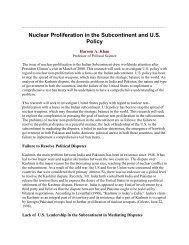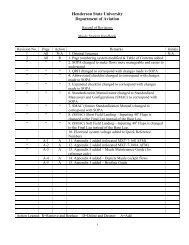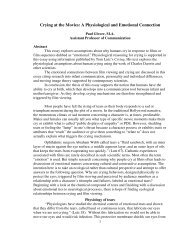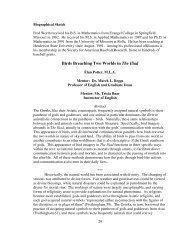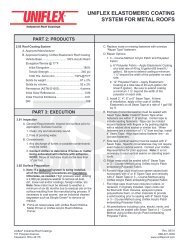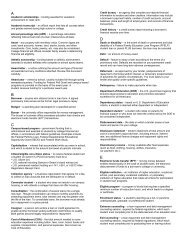Inferential Statistics using the Coefficient of Variation ...
Inferential Statistics using the Coefficient of Variation ...
Inferential Statistics using the Coefficient of Variation ...
You also want an ePaper? Increase the reach of your titles
YUMPU automatically turns print PDFs into web optimized ePapers that Google loves.
Academic Forum 26 2008-09<br />
The small p-value is evidence that <strong>the</strong> variance in <strong>the</strong> lengths <strong>of</strong> <strong>the</strong> females is greater than that<br />
<strong>of</strong> <strong>the</strong> males. However, doing a 2-sample t-test will provide evidence that female lynx spiders<br />
are longer on average than male lynx spiders. Since <strong>the</strong> female spiders tend to be longer, it<br />
would be more appropriate to compare <strong>the</strong> sex difference in length for <strong>the</strong> lynx spider <strong>using</strong> a<br />
statistic that measures variation relative to length. The coefficient <strong>of</strong> variation is such a statistic<br />
s<br />
and is defined to be CV = 100 . For <strong>the</strong> above data,<br />
x<br />
CV M = 100*.663/5.92 = 11.2 and CV F = 100*1.19/8.15 = 14.6, so CV M < CV F ,<br />
but is this difference significant? We will need to determine <strong>the</strong> distribution <strong>of</strong> <strong>the</strong> CV random<br />
s<br />
variable, so for simplicity <strong>the</strong> 100 in <strong>the</strong> formula will be dropped and we redefine CV = .<br />
x<br />
We will assume for <strong>the</strong> remainder <strong>of</strong> this paper that X<br />
1<br />
, X<br />
2,...,<br />
X<br />
n<br />
is a simple random sample<br />
from N ( µ , σ ) where µ > 0.<br />
Recall <strong>the</strong> following <strong>the</strong>orem:<br />
1<br />
Theorem X =<br />
n<br />
n<br />
∑ X j<br />
j=<br />
1<br />
2<br />
( n −1)<br />
S 2<br />
~ χ ( n −1).<br />
2<br />
σ<br />
1 ⎛ σ ⎞<br />
S = ∑ X − X j<br />
are independent, and X ~ N⎜µ,<br />
⎟ and<br />
n −1<br />
j=<br />
1<br />
⎝ n ⎠<br />
n<br />
and ( ) 2<br />
2<br />
We will derive <strong>the</strong> distribution <strong>of</strong> <strong>the</strong> standard deviation. Recall that <strong>the</strong> probability density<br />
function <strong>of</strong> ~ 2 2 2<br />
u e<br />
U χ ( n −1)<br />
is fU<br />
( u)<br />
= , u > 0, n = 2,3,...<br />
. Write<br />
n−1<br />
⎛ n −1⎞<br />
2<br />
Γ⎜<br />
⎟2<br />
⎝ 2 ⎠<br />
S =<br />
2<br />
σ ( n −1)<br />
S<br />
⋅<br />
2<br />
( n −1)<br />
σ<br />
2<br />
=<br />
f ( s)<br />
= f<br />
S<br />
σ<br />
n −1<br />
U<br />
1<br />
=<br />
⎛ n −1⎞<br />
Γ⎜<br />
⎟2<br />
⎝ 2 ⎠<br />
n−2<br />
s<br />
=<br />
⎛ n −1⎞<br />
Γ⎜<br />
⎟2<br />
⎝ 2 ⎠<br />
n−1<br />
2<br />
n−3<br />
2<br />
U<br />
du<br />
( u)<br />
ds<br />
n−3<br />
u<br />
−<br />
. Apply <strong>the</strong> change-<strong>of</strong>-variable technique to obtain<br />
⎡(<br />
n −1)<br />
s<br />
⎢ 2<br />
⎣ σ<br />
2<br />
⎡(<br />
n −1)<br />
⎤<br />
⎢ 2 ⎥<br />
⎣ σ ⎦<br />
⎤<br />
⎥<br />
⎦<br />
n−1<br />
2<br />
n−3<br />
2<br />
⎡ ( n −1)<br />
s<br />
exp⎢−<br />
2<br />
⎣ 2σ<br />
⎡ ( n −1)<br />
s<br />
exp⎢−<br />
2<br />
⎣ 2σ<br />
2<br />
2<br />
⎤<br />
⎥<br />
⎦<br />
d<br />
ds<br />
⎤<br />
⎥,<br />
s > 0<br />
⎦<br />
⎡(<br />
n −1)<br />
s<br />
⎢ 2<br />
⎣ σ<br />
2<br />
⎤<br />
⎥<br />
⎦<br />
20




